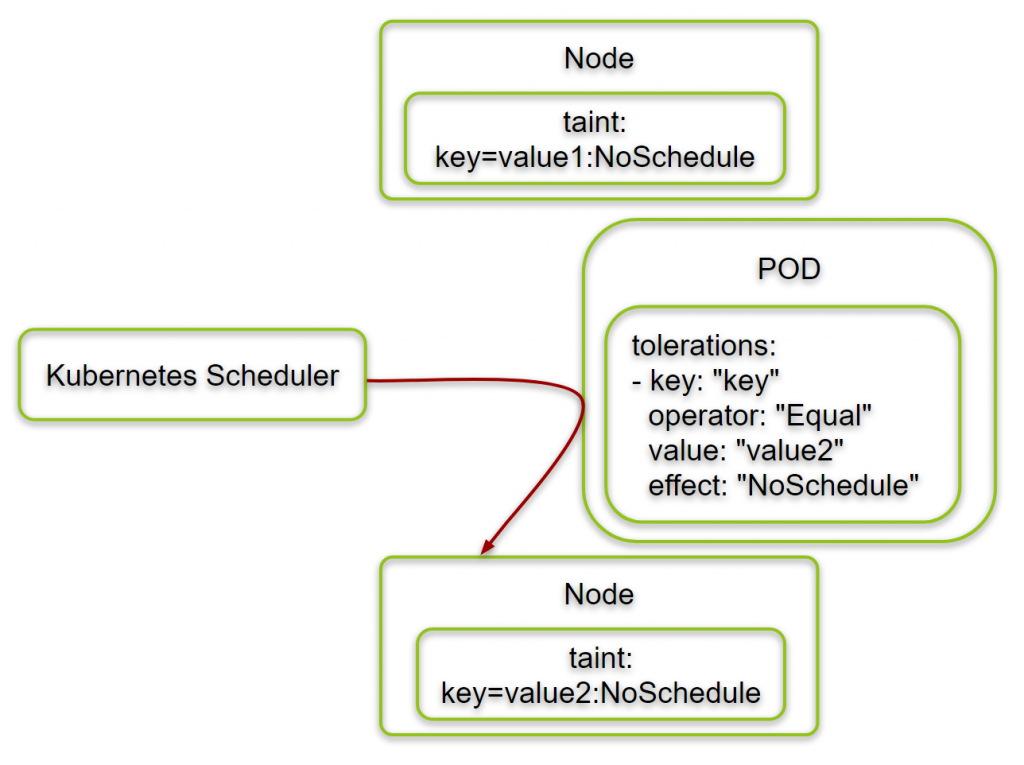What is meaning of taint?
a trace of a bad or undesirable substance or quality.
What is tainted?
spoiled; damaged in quality, taste, or value.
What is toleration?
the practice of tolerating something, in particular differences of opinion or behaviour.
Here in Kubernetes, we use taint with nodes and Tolerations with Pod.
- Node affinity, is a property of Pods that attracts them to a set of nodes (either as a preference or a hard requirement).
- Taints are the opposite — they allow a node to repel a set of pods.
- Tolerations – Tolerations are applied to pods, and allow (but do not require) the pods to schedule onto nodes with matching taints.
Taints and tolerations work together to ensure that pods are not scheduled onto inappropriate nodes. One or more taints are applied to a node; this marks that the node should not accept any pods that do not tolerate the taints.

Lets understand using taint with one or more nodes in Kubernetes first.
The default value for operator is Equal.
A toleration “matches” a taint if the keys are the same and the effects are the same, and:
- the operator is Exists (in which case no value should be specified), or
- the operator is Equal and the values are equal.
Here’s an example of a pod that uses tolerations:
| ## You add a taint to a node using kubectl taint | |
| # kubectl taint nodes node1 key=value:NoSchedule | |
| ## To remove the taint added by the command above, you can run: | |
| # kubectl taint nodes node1 key:NoSchedule- | |
| apiVersion: v1 | |
| kind: Pod | |
| metadata: | |
| name: nginx | |
| labels: | |
| env: test | |
| spec: | |
| containers: | |
| - name: nginx | |
| image: nginx | |
| imagePullPolicy: IfNotPresent | |
| tolerations: | |
| - key: "example-key" | |
| operator: "Exists" | |
| effect: "NoSchedule" | |
| apiVersion: v1 | |
| kind: Pod | |
| metadata: | |
| name: nginx | |
| labels: | |
| env: test | |
| spec: | |
| containers: | |
| - name: nginx | |
| image: nginx | |
| imagePullPolicy: IfNotPresent | |
| tolerations: | |
| - key: "key" | |
| operator: "Equal" | |
| value: "value" | |
| effect: "NoSchedule" |
I’m a DevOps/SRE/DevSecOps/Cloud Expert passionate about sharing knowledge and experiences. I am working at Cotocus. I blog tech insights at DevOps School, travel stories at Holiday Landmark, stock market tips at Stocks Mantra, health and fitness guidance at My Medic Plus, product reviews at I reviewed , and SEO strategies at Wizbrand.
Do you want to learn Quantum Computing?
Please find my social handles as below;
Rajesh Kumar Personal Website
Rajesh Kumar at YOUTUBE
Rajesh Kumar at INSTAGRAM
Rajesh Kumar at X
Rajesh Kumar at FACEBOOK
Rajesh Kumar at LINKEDIN
Rajesh Kumar at PINTEREST
Rajesh Kumar at QUORA
Rajesh Kumar at WIZBRAND

